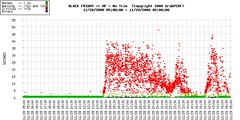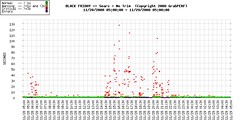The GrabPERF Black Friday Dashboard is done for another year and there were two performance victims that suffered the most at the hands of the onslaught of bargain-hunters in the area of Web performance.
Some caveats that I need to mention about the GrabPERF measurement methodology.
- Only the base HTML file of each site is measured.
- Only the base HTML of the homepage is measured. This means that any issues that arose in the shopping process were not captured.
All of the sites in the GrabPERF Holiday Retail Measurement Index can be continually monitored on the GrabPERF Black Friday Dashboard. This page will be available until January 1 2009.
That said, the two primary performance victims this year are HP Shopping and Sears. We focus here on those that did not do that well because sites who have met the Web performance challenge and survived to fight another year are not as interesting from a learning perspective.
HP Shopping
HP Suffered the greatest response time problems, by effectively becoming unresponsive as of 09:00 EST. The greatest affect on overall response time came as a result of the First Byte time metric which is a solid proxy for measuring the server or application load, as it is the time between the initial client HTTP request and the server’s HTTP response.
Factored into the poor performance analysis is the fact that GrabPERF only captures data for the base HTML object. If the performance seen here is carried over to the download of all of the graphical content on the page, I would be surprised if anyone was able to make any kind of purchases on the HP web site on Black Friday.
Today, performance has returned to substantially lower levels, indicating that this application was simply not ready for the amount of traffic it received, or ran into a completely unexpected issue when the load increased.
Recommendation for 2009: Load Test the application using this year’s traffic metrics as a baseline for validating the scalability of the application.
Sears
Sears is a returning visitor from last year’s Black Friday measurements. Unfortunately, they return for exactly the same reason that they were on last year – scaling/capacity issues that appear as errors.
And these are the worst kind of errors. As can be seen in the graphic below, the Sears Web site announced to the whole world that they had over-reached and that they could not handle the incoming volume of traffic.
What is interesting is that Sears owns properties that survived the day very well, namely Lands End. The question that must be posed is why does the parent site fail so badly when the child sites handle the traffic without difficulty?
Recommendation for 2009: Load testing for capacity, and meeting with the Lands End team to understand what they are doing to handle the load.



